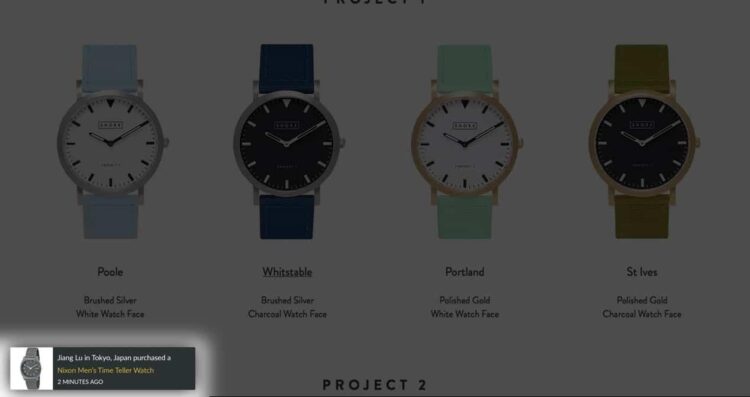To be honest, applying this solution will have a positive impact on all key e-commerce parameters of your website such as its conversion rate, average order, and customer lifetime value.
In today’s article, we’ll let the cat out of the bag and tell you about 6 most effective methods of applying social proof. Bringing these tips to life will allow you to follow marketing strategies of the greatest e-commerce tycoons and begin your journey leading to becoming one of them!
 Project 2 notifies customers of recently purchased goods.[/caption]
Project 2 notifies customers of recently purchased goods.[/caption]
 REI displays the "Norton Secured" sign to customers finalizing the transaction.[/caption]
Mentioning awards or logos of popular brands whose products are on your offer as well as quality media platforms writing about your company will help you to inspire the trust of your potential customers and convince them that doing business with you is a great idea. The above-mentioned information should be placed in headers or sidebars that extend across the entire website.
REI displays the "Norton Secured" sign to customers finalizing the transaction.[/caption]
Mentioning awards or logos of popular brands whose products are on your offer as well as quality media platforms writing about your company will help you to inspire the trust of your potential customers and convince them that doing business with you is a great idea. The above-mentioned information should be placed in headers or sidebars that extend across the entire website.
 Amazon fills the product page with various content related to the product.[/caption]
Crutchfield is another company that operates in a similar way and enables customers to ask for expert advice. Such a step does not only help to resolve any customers’ doubts but also suggests that experts vouch for a given product.
[caption id="attachment_20423" align="aligncenter" width="750"]
Amazon fills the product page with various content related to the product.[/caption]
Crutchfield is another company that operates in a similar way and enables customers to ask for expert advice. Such a step does not only help to resolve any customers’ doubts but also suggests that experts vouch for a given product.
[caption id="attachment_20423" align="aligncenter" width="750"] It’s possible to obtain expert help on the Crutchfield website.[/caption]
Don’t forget to inform about celebrities and influencers that use your products and are satisfied with the purchase. This technique was implemented by Snow, a company selling teeth whitening products.
[caption id="attachment_20425" align="aligncenter" width="750"]
It’s possible to obtain expert help on the Crutchfield website.[/caption]
Don’t forget to inform about celebrities and influencers that use your products and are satisfied with the purchase. This technique was implemented by Snow, a company selling teeth whitening products.
[caption id="attachment_20425" align="aligncenter" width="750"] After all, it’s hard to argue with Rob Gronkowski, the multiple winners of The Super Bowl.[/caption]
After all, it’s hard to argue with Rob Gronkowski, the multiple winners of The Super Bowl.[/caption]
 Amazon displays customers' photos, consequently no one is afraid that the reviews are fake.[/caption]
Specific case studies boasting how your products or services helped customers is a great social proof solution, especially when it comes to top-shelf goods. Longer, more detailed, and engaging stories are reliable and can have a stronger impact on the customers' decision-making process.
[caption id="attachment_20429" align="aligncenter" width="750"]
Amazon displays customers' photos, consequently no one is afraid that the reviews are fake.[/caption]
Specific case studies boasting how your products or services helped customers is a great social proof solution, especially when it comes to top-shelf goods. Longer, more detailed, and engaging stories are reliable and can have a stronger impact on the customers' decision-making process.
[caption id="attachment_20429" align="aligncenter" width="750"] Marucci, a baseball bat seller, provides potential customers with feedback and references from previous buyers.[/caption]
Marucci, a baseball bat seller, provides potential customers with feedback and references from previous buyers.
Marucci, a baseball bat seller, provides potential customers with feedback and references from previous buyers.[/caption]
Marucci, a baseball bat seller, provides potential customers with feedback and references from previous buyers.
 Vanity Planet has a separate section for customers’ Instagram photos on its product pages.[/caption]
Vanity Planet has a separate section for customers’ Instagram photos on its product pages.[/caption]
Social proof - what is it and how does it work?
Social proof is a proven and documented concept that comprises many categories, from sociological issues to business strategies. In a nutshell, this concept assumes that virtually everyone is affected by actions performed by other people. Therefore, it can be stated that we have an innate need or desire to follow others. Robert B. Cialdini, a professor of psychology, is considered to be responsible for popularizing this concept because as he wrote in his book “Influence”:“Without question, when people are uncertain, they are more likely to use others’ actions to decide how they themselves should act.”He also stated that:
“If a lot of people are doing the same thing, they must know something we don’t”.Although, as stressed by Cialdini, social proof is a multi-faceted concept, in the end it boils down to the fact that humans act accordingly to their instincts of “being a herd animal". Business-wise, social proof concerns the customer’s assumption that if a significant group of people took a certain action or bought a given product, they must have had a pretty important reason to do it. Taking into consideration the fact that 72% of customers trust online reviews, it becomes apparent that the social proof concept is pretty relevant. Even if these reviews were manipulated by post-shopping emails or any other methods, customers will still take them into account because the majority of them aren't aware of the background. It’s also worth mentioning that social proof helps us comprehend other useful e-commerce techniques such as the use of urgency psychology or the FOMO (fear of missing out) concept. In both cases, creating an impression that the “herd” behaves in a specific way gives rise to a desire to make a purchase. That’s it as far as the introduction is concerned. Let’s move on to specific strategies.
1. Take advantage of trust-building customer reviews to improve your conversion rate
There’s tangible evidence that reviews and opinions do their job. If your product pages don’t include any reviews, it certainly affects your conversion rate negatively. Below you can find a few tips suggesting how to take advantage of customer reviews:- Generate more reviews with the use of follow-up emails - sending follow-up emails to your customers after they’ve purchased your products is the most effective way to encourage them to write reviews. It’s also a good idea to offer your customers some kind of rewarding incentive such as a voucher or discount for the next shopping. Remember to try out various e-mail patterns to see which improves your conversion the most.
- Provide a place to review products at the top of the page - this solution is already implemented by e-commerce giants such as Walmart or Amazon. Providing the bar with an average rating at the top of the product page helps you ensure that all users, not only those who scroll the page to see all reviews, are affected by the message.
- Don’t freak out when you see some negative feedback - many shop owners are really afraid of being assessed negatively. But the research clearly indicates that it’s much better to have many positive reviews and a few negative ones than not to have any reviews at all. Remember that you can always blunt the message conveyed in the unflattering comments by replying to them in an appropriate way.
2. Display current customer interest in a given product
This point is the essence of social proof. According to the principle of following the crowd, showing that others are interested in a given product is a perfect trigger to motivate your potential customers to make a purchase. Besides, you’re probably well familiarized with this strategy thanks to portals such as Booking.com or Airbnb which display notifications when clients make transactions or when there is a strong demand for a product or service. What’s more, this method arouses feelings connected to FOMO, urgency and shortage. Booking.com shows how many people have checked out a given room in the last 10 minutes and when the last booking was made. You can use the following methods to indicate users’ interest in a given product:- Notify users of limited stocks - if the available quantity of a product is limited, clearly indicate this right next to the main Call To Action (CTA).
- show which models are out of stock - by providing information that a given product model is unavailable, you automatically prove that buyers are highly interested in the product.
- Display notifications concerning recently made purchases - if someone decides to buy your products, display a pop-up notification informing about it.
 Project 2 notifies customers of recently purchased goods.[/caption]
Project 2 notifies customers of recently purchased goods.[/caption]
- Provide the number of purchases made over the last 24 hours - if only possible, inform your visitors how many people decided to take advantage of your offer over the last 24 hours.
- Clearly indicate product seasonality - if you expect a certain product to be more popular during specific time periods such as Christmas or Mother's Day, let your (potential) customers know about it! They’re more likely to trust slogans like "product may be out of stock soon" and get influenced by them, especially if such notifications are linked to a particular event.
3. Provide information concerning safety, awards or partner brands to inspire trust
Publish information concerning safety close to the CTA button and at the checkout page in order to inspire customers’ trust which is especially important at the final shopping stage, namely while finalizing the order. A significant part of the safety “badges” mention well-known brands such as Norton which is a notable proof of reliability. [caption id="attachment_20419" align="aligncenter" width="1366"] REI displays the "Norton Secured" sign to customers finalizing the transaction.[/caption]
Mentioning awards or logos of popular brands whose products are on your offer as well as quality media platforms writing about your company will help you to inspire the trust of your potential customers and convince them that doing business with you is a great idea. The above-mentioned information should be placed in headers or sidebars that extend across the entire website.
REI displays the "Norton Secured" sign to customers finalizing the transaction.[/caption]
Mentioning awards or logos of popular brands whose products are on your offer as well as quality media platforms writing about your company will help you to inspire the trust of your potential customers and convince them that doing business with you is a great idea. The above-mentioned information should be placed in headers or sidebars that extend across the entire website.
4. Present experts' reviews, media recommendations, and influencers who mention your brand
People trust professionals, therefore, their opinions are crucial and embody the concept of social proof. Consequently, a sizable part of online stores tends to quote expert recommendations or even make them the key element of their value proposition. Amazon which quotes third-party reviews on its product pages alongside related videos and customer reviews is a perfect example of applying this rule. [caption id="attachment_20421" align="aligncenter" width="750"] Amazon fills the product page with various content related to the product.[/caption]
Crutchfield is another company that operates in a similar way and enables customers to ask for expert advice. Such a step does not only help to resolve any customers’ doubts but also suggests that experts vouch for a given product.
[caption id="attachment_20423" align="aligncenter" width="750"]
Amazon fills the product page with various content related to the product.[/caption]
Crutchfield is another company that operates in a similar way and enables customers to ask for expert advice. Such a step does not only help to resolve any customers’ doubts but also suggests that experts vouch for a given product.
[caption id="attachment_20423" align="aligncenter" width="750"] It’s possible to obtain expert help on the Crutchfield website.[/caption]
Don’t forget to inform about celebrities and influencers that use your products and are satisfied with the purchase. This technique was implemented by Snow, a company selling teeth whitening products.
[caption id="attachment_20425" align="aligncenter" width="750"]
It’s possible to obtain expert help on the Crutchfield website.[/caption]
Don’t forget to inform about celebrities and influencers that use your products and are satisfied with the purchase. This technique was implemented by Snow, a company selling teeth whitening products.
[caption id="attachment_20425" align="aligncenter" width="750"] After all, it’s hard to argue with Rob Gronkowski, the multiple winners of The Super Bowl.[/caption]
After all, it’s hard to argue with Rob Gronkowski, the multiple winners of The Super Bowl.[/caption]
5. Enable customers to add elaborate reviews complemented with photos or videos
Encourage customers to write more elaborate reviews with additional visual elements such as photos and videos. This will make the feedback even more reliable. Moreover, it's also a great, engaging part of your interaction with customers. [caption id="attachment_20427" align="aligncenter" width="750"] Amazon displays customers' photos, consequently no one is afraid that the reviews are fake.[/caption]
Specific case studies boasting how your products or services helped customers is a great social proof solution, especially when it comes to top-shelf goods. Longer, more detailed, and engaging stories are reliable and can have a stronger impact on the customers' decision-making process.
[caption id="attachment_20429" align="aligncenter" width="750"]
Amazon displays customers' photos, consequently no one is afraid that the reviews are fake.[/caption]
Specific case studies boasting how your products or services helped customers is a great social proof solution, especially when it comes to top-shelf goods. Longer, more detailed, and engaging stories are reliable and can have a stronger impact on the customers' decision-making process.
[caption id="attachment_20429" align="aligncenter" width="750"] Marucci, a baseball bat seller, provides potential customers with feedback and references from previous buyers.[/caption]
Marucci, a baseball bat seller, provides potential customers with feedback and references from previous buyers.
Marucci, a baseball bat seller, provides potential customers with feedback and references from previous buyers.[/caption]
Marucci, a baseball bat seller, provides potential customers with feedback and references from previous buyers.
6. Put emphasis on social media activity of your company
Properly applied badges and mentions of your brand in social media are one of the most effective tools of the social proof concept. You can, for example, provide information concerning the number of your followers in the sidebar or header. It’s also a great idea to display photos of customers wearing or using your products. This principle is perfectly implemented by Vanity Planet which publishes on its product pages Instagram pictures of customers using its devices. [caption id="attachment_20431" align="aligncenter" width="750"] Vanity Planet has a separate section for customers’ Instagram photos on its product pages.[/caption]
Vanity Planet has a separate section for customers’ Instagram photos on its product pages.[/caption]


![How to Create an Ad That Will STAND Out? + [VIDEO]](https://delante.co/wp-content/uploads/2023/11/how-to-create-ads-that-stand-out.jpg)









